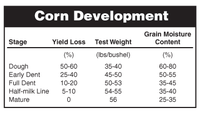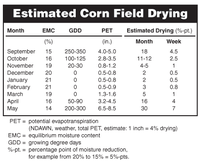High-moisture Corn Again Expected at Harvest
(Click an image below to view a high-resolution image that can be downloaded)
This year’s poor growing conditions mean corn likely will contain high levels of moisture at harvest for the second year in a row, a North Dakota State University grain drying expert warns.
“If the corn has reached full dent but not full maturity, a small reduction in test weight and yield might be expected for the corn this year,” says Ken Hellevang, NDSU Extension Service agricultural engineer. “Corn at full dent is expected to have a yield loss of 10 percent to 20 percent, a test weight of 50 to 53 pounds per bushel and a moisture content of 35 percent to 45 percent.”
At the half-milk line, the yield loss is expected to be about 5 percent to 10 percent, the test weight is expected to be about 54 to 55 pounds per bushel and moisture content is expected to be about 35 percent to 40 percent. Even though test weight and yield will be good, the moisture content will be about 30 percent if corn has only just reached maturity.
The amount of drying in the field depends on parameters such as corn maturity, hybrid, moisture content, air temperature and relative humidity, solar radiation and wind speed, Hellevang says.
Corn growing degree days have been used to predict the rate of field drying. Another predictor of the drying rate is potential evapotranspiration (PET), which is based on parameters similar to those that affect drying. Values for PET are available on the North Dakota Agricultural Weather Network Web site at http://ndawn.ndsu.nodak.edu/. About 1 inch of potential evapotranspiration results in about 4 percentage points of corn field drying.
Standing corn in the field may dry about 2.5 percentage points per week during October, assuming normal weather conditions, and about 1 percentage point per week during November. Corn at 35 percent moisture content on Oct. 11 might be expected to dry to about 27 percent by Nov. 1 and about 22 percent by Dec. 1. Therefore, corn moisture content at harvest likely will be in the mid-20 percent range again this year.
Field drying normally is more economical until mid to late October and mechanical high-temperature drying normally is more economical after that.
Field drying is extremely slow during winter months and corn will dry only to about 20 percent moisture content based on the equilibrium moisture content for average monthly air temperature and relative humidity conditions. Corn that remained in the field during the winter of 2008-09 dried from 25 percent to 30 percent moisture in November to 17 percent to 20 percent when harvested in February and early March. Corn losses generally were small if the corn stalk was strong in November.
Numerous producers have reported weak corn stalks this year, so field losses might be much greater this year than last year, Hellevang says. He recommends examining the stalks and pushing on them to determine stalk condition before deciding to leave corn standing in the field through the winter. Accumulated snow plus cover on the snow and ground from unharvested corn resulted in wet fields in the spring.
For more information on high-moisture corn, do an Internet search for NDSU corn drying or visit http://www.ag.ndsu.nodak.edu/abeng/postharvest.htm.
NDSU Agriculture Communication
| Source: | Ken Hellevang, (701) 231-7243, kenneth.hellevang@ndsu.edu |
|---|---|
| Editor: | Ellen Crawford, (701) 231-5391, ellen.crawford@ndsu.edu |



